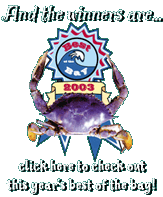Editorial
Alien Oysters: A Recipe for Trouble?
We don’t know what the answer is.
So this week, when oysters feature in Bay Weekly, we’re breaking editorial law. Instead of telling you what we think, we’re asking what you think.
The question that has us stumped is Chesapeake oysters.
Finally, we’re scraping the bottom of that magic Bay barrel that refilled itself over so many centuries. Only 53,000 bushels, an all-time low, were harvested in the 2002–2003 season. Smaller still are expectations for the harvest this season, which runs from October through March.
Our oysters are in a world of trouble, most of it manmade. The byproducts of our inhabitation of Chesapeake Country have made the Bay a tough place for oysters to live. At the same time, our appetite for oysters has outgobbled the resource. Now few and weak, the Bay’s remaining oysters are dying of infection by the microscopic oyster predators Dermo and MSX. Wouldn’t you know it, one of them, MSX, was turned loose in the Bay by humans.
We’ve all been counseled that failing to learn history’s lessons dooms us to repeating its mistakes. So the story of MSX — released as a hitchhiker on Asian oysters somebody a few decades ago imagined would be just the thing to repopulate the Bay — sends cautionary shivers down our spines.
We’re shivering because repopulating the Bay with Asian oysters has returned this century as the contending solution to our oyster trouble.
No, today’s contender, Ariakensis, isn’t the oyster that brought us MSX. Yes, Ariakensis is being studied in labs and open water in Virginia and North Carolina and more recently in Maryland. Yes, controls are in place; among them, Ariakensis is being neutered to stop test oysters from leaping ahead to reproduction.
But we’re still shivering, because the one thing we know with certainty is that the consequences of every action far outstrip mortal anticipation.
What else are we to do? ask the supporters of Ariakensis, which now include not only key Virginia scientists but also our own Department of Natural Resources under Gov. Robert Ehrlich.
In finding ways to keep our native oysters alive, we’ve pushed the limits of human ingenuity. To get Crassostrea virginica to grow, scientists and entrepreneurs have tried hundreds of variations on seed, seed-planting and reef building. Even turning Baltimore’s hall of sports fame, Memorial Stadium, into oyster reefs hasn’t turned the tide.
So what are we to do? is the key question. We’re eager to hear your answers.
Write to editor Sandra Martin: [email protected] or P.O. Box 358, Deale, MD 20751.

